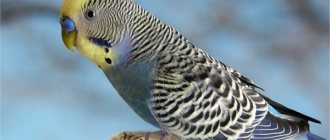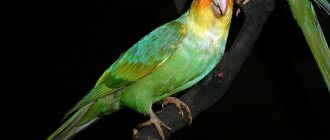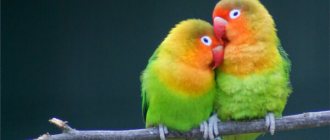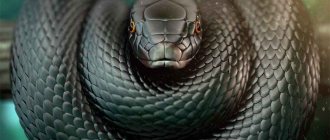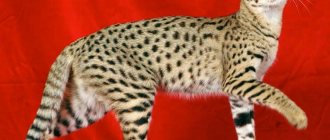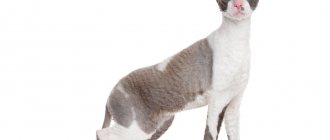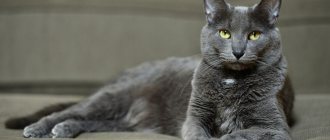Lovebirds and their exotic appearance
Lovebirds are considered small parrots. Their body length does not exceed 17 centimeters, and their weight barely reaches 60 grams. The wings of these birds are quite short; when spread, their length is 4 centimeters. Compared to the body, the bird's head is large. Lovebirds can have different colors, but the main color of their plumage is always green. Additional colors of feathers can be pink, red, yellow, blue and others.
Despite their small size, lovebirds can cause harm not only to predators that attack them, but also to humans. A thick and strong beak, strongly curved towards the tip, allows birds of this species to inflict severe injuries on opponents of different sizes. Lovebirds prefer to run away from animals and fellow creatures that pose a danger rather than fly away. Short wings do not give them the ability to cover long distances, but strong paws help them move quickly and briskly over any terrain. Birds are excellent tree climbers, so if danger arises they can easily hide in foliage or an abandoned hollow.
The description of lovebirds may vary slightly depending on what species they belong to. There are certain similarities between all individuals of the genus regarding size and behavior. However, each species has its own characteristic differences that make it possible to distinguish the bird from many others.
Liliana's lovebird
Liliana's lovebird
The length of these birds is about 13.5 cm from beak to tail, and their weight is 28 - 37 grams. These are one of the smallest representatives of this family. The plumage is mostly green. The forehead and neck are orange-red, the withers, face and upper chest are pale pink. The upper part of the tail is green, the side feathers are dark at the base with yellowish-orange edges. The eyes are red-brown with an unfeathered periocular ring. The beak is red. Liliana lovebirds are distributed in Malawi, northwestern Mozambique, southern Tanzania, eastern Zambia and Zimbabwe.
Types of lovebirds
Currently, scientists know 9 species of lovebirds. Some of them have subspecies that have minor differences and some features.
- Collared lovebird
The bird got its name because of the contrasting plumage in the neck area. Orange feathers set against a black background look like a spectacular necklace adorning the bird. Lovebirds of this species have green plumage, a blackish beak, a dirty yellow chest and an ultramarine blue rump. The combination of such bright shades allows the bird to look catchy and exotic.
- Liliana's lovebirds
Representatives of this species were named after the sister of zoologist William Sclater, who first described these exotic birds. Liliana's lovebirds are distinguished by their delicate colors, which contain muted shades of green, yellow and red. The appearance of the bird is in many ways similar to the rosy-cheeked lovebird. A characteristic feature that allows you to distinguish birds of this species is the strawberry coloring of the head and throat. Male and female Liliana lovebirds are very similar in appearance, making it difficult to tell them apart.
- Masked lovebird
The plumage of individuals of this species is dominated by yellow-orange shades. The belly, back, tail and wings are colored green, the head is black, and the beak is red. The differences between the female and the male are insignificant. Female lovebirds are distinguished by less saturated colors of the feathers on their heads. If in males they are dark black, then in females they are black-brown. At home, lovebirds of this species quickly become accustomed and easily get used to their owner.
- Red-faced lovebird
The main color of the plumage is grass-green. Against its background, shades of orange-red, which predominate in the throat, cheeks, back of the head and forehead, look bright and contrasting. While some lovebird species exhibit subtle sexual dimorphism, red-faced parrots have a number of characteristic differences between males and females. In female birds, the head is yellow-orange, and the rest of the plumage is yellowish-green.
- Rosy-cheeked lovebird
These lovebirds are attractive due to their intense colors. The front part of the bird's body is green, the back part is blue. The cheeks and throat of the birds are painted pink, the forehead is bright red, and the beak is straw yellow. Heterogeneous colors are also characteristic of the tail feathers. Green tail feathers, red side feathers with black stripes and bright blue coverts make this species of lovebirds even more striking and attractive.
- Grey-headed lovebird
Like most lovebirds, birds of this species are predominantly green in color. The wings and back are slightly darker, while the belly and tail are lighter. Males have a light gray head, neck and upper chest, while females are grey-green or light green. These lovebirds are endowed with a beautiful dark brown iris and a light gray beak, which can also be used to distinguish them from other members of the genus.
- Fisher's lovebird
At home, lovebirds of this species live longer than in the wild. The species became known thanks to the German researcher Gustav Fischer, who observed the life of parrots in Africa. In 1887, the birds he discovered were given his name. Fischer's lovebirds differ from their relatives in the color of their beak, head and rump. Their beak is red, their head is yellow-orange, and their rump is blue.
- Black-winged lovebird
While other lovebird species reach a maximum of 15 centimeters in length, black-winged individuals can reach up to 17 centimeters in length. The main color of the plumage is grass-green. Some parts of the body of males are painted bright red (forehead, border around the eyes and beak). There is a black border on the tail feathers, tips and lower parts of the wings.
- Black-cheeked lovebird
Representatives of this species are the most graceful lovebirds. They are similar to their masked counterparts, but are noticeably smaller, and their plumage is much brighter. The head of black-cheeked parrots is light gray, the cheeks, as the name of the species suggests, are black, and the upper part of the breast is red. Red color is also present in the beak coloration.
Rosy-cheeked lovebird
Rosy-cheeked lovebird
The rosy-cheeked lovebird is the most popular and common type of lovebird among bird owners. These little parrots are active and playful. They are very intelligent and will make excellent companions for the right owner. Like other lovebirds, rosy-cheeked ones need constant communication and interaction. This is a very important factor for their happiness and well-being. The plumage of these parrots is bluish-green with bright blue feathers on the back of the body and the top of the tail. The neck and cheeks are bright pink, and the feathers on the forehead are red. The pink-cheeked ones reach 16–18 cm in length. They live in the arid regions of Angola. There are many mutations of this species.
Habitat
If at home lovebirds can live in almost any corner of the globe, then in the wild they settle only in Africa and Madagascar. The choice of residence depends on the type of bird. Thus, the collared lovebird prefers to live in the center and west of the African continent. Liliana lovebirds choose to live in acacia savannas located in the northern regions of Mozambique, eastern Zambia, southern Tanzania and Malawia. Masked lovebirds prefer savannas rich in acacias and baobabs. There are many similar ones in Kenya and Tanzania.
Red-faced parrots can live in both Tanzania and Ethiopia, Sierra Leone and the island of Sao Tome. To arrange their homes, they choose savannas, in which low-growing trees grow. Rose-cheeked lovebirds live in Namibia and Angola. These regions have many desert areas in which birds find a place to live closer to people. Grey-headed specimens are partial to the islands. They are most often found in the Seychelles, Zanzibar, Mauritius and Madagascar. Unlike their pink-cheeked counterparts, gray-headed lovebirds do not like dry places, so they live in forests, palm plantations and groves.
The only species that has chosen Lake Victoria is Fischer's lovebird. Birds of this species feel comfortable in savannas located at an altitude of about 1700 meters above sea level. Therefore, in addition to Lake Victoria, lovebirds of this species inhabit the territory of Northern Tanzania. Black-winged parrots are called mountain lovers. They avoid communication with people, so they nest in forests growing at an altitude of 1500 to 3300 meters above sea level. These lovebirds are most common in Eritrea and Ethiopia. The black-cheeked species of the family is not so favorable to heights, therefore it spends its life in deciduous forests at an altitude of up to 1500 meters above sea level.
Lovebirds are the most positive among parrots - 24 photos
Lovebirds (lat. Agapornis) are a genus of birds of the parrot family. Lovebirds are small birds. They are easily tamed and enjoy deserved popularity among parrot lovers. Unpretentious. They have a bright, beautiful color. They are lively and active in nature and a pleasure to watch.
They are practically not amenable to training; individuals capable of remembering words are rarely found. The birds received the name “lovebirds” due to their way of life: parrots choose a mate and remain faithful to each other throughout their lives. You can often see birds sitting tightly pressed against each other. In captivity, lovebirds live for about 20 years.
In appearance, lovebirds are graceful and beautiful. The color of the plumage is bright, with a predominance of green. Some parts of the body - the head, chest, neck - are often painted in a different color (red, blue, yellow) - due to this, parrots look unusually bright. Lovebirds are miniature in size. Body length is about 17 cm, wing length is 10 cm. Body weight is about 50 grams. The legs are short: lovebirds run well on the ground and climb tree branches. The head is large, making the birds look stocky. Lovebirds have a very strong, curved beak.
The beak color is usually red or yellow. With this thick, strong beak, birds are capable of injuring the enemy. When keeping several species of birds in an aviary, lovebirds treat strangers quite jealously, and with their beaks they can injure even larger birds. The tail of lovebirds is not long (about 5 cm), rounded.
The homeland of lovebirds is South-East and South-West Africa. Birds also inhabit Madagascar and some other nearby islands. For living, lovebirds choose dense tropical forests, mainly near rivers or lakes.
The genus includes 9 species: Grey-headed lovebird Agapornis canus (Gmelin, 1788) Fischer's lovebird Agapornis fischeri Reichenow, 1887 Strawberry-headed lovebird Agapornis lilianae Shelley, 1894 Black-cheeked lovebird Agapornis nigrigenis WL Sclater, 1906 Masked lovebird Agapornis personatus Reich enow, 1887 Orange-headed lovebird Agapornis pullarius (Linnaeus, 1758) Rosy-cheeked lovebird Agapornis roseicollis (Vieillot, 1818) Green-winged lovebird Agapornis swindernianus (Kuhl, 1820) Black-winged lovebird Agapornis taranta (Stanley, 1814)
The very name of these parrots – “lovebirds” – characterizes their way of life. Parrots find a mate and remain faithful to their partner all their lives. Lovebirds live in small flocks, families formed from several pairs.
Parrots live in tropical rainforests. Typically, lovebirds choose places rich in water resources. Some flocks prefer to live in areas close to farms and periodically carry out predatory raids on farmers' fields in search of food.
Due to their strong short legs and strong beak, lovebirds are good at climbing tree branches and running on the ground. Birds feed on plant seeds and berries, and peck food directly from a tree or bush, and do not use their paws, like many other species of parrots. Lovebirds fly well, their flight is often accompanied by screaming. Lovebirds spend the night in trees. Nests are made in hollows, but there are species that prefer to dig out their homes in the form of burrows.
The construction of the nest is carried out by the female, who builds a nest using twigs, pieces of bark and bast strips. Birds carry material for making a nest in the feathers of their back and neck, but some species also use their beak for this. Lovebirds behave quite aggressively towards birds of other species. In case of conflicts, lovebirds with their strong beaks can injure enemies, even if they are larger birds.
In the wild, lovebirds eat berries or plant seeds. Parrots get them on the ground, and also peck from bushes or trees. At the same time, unlike most other parrots, lovebirds do not use their paws when eating and do not use them to transfer food into their beak.
Reproduction of articles and photographs is permitted only with a hyperlink to the site:
| White cat wallpaper | Green bamboo stems | Color pictures of flowers |
| Gifts of Autumn | White mustang | Puppy and rose |
| Pictures of yellow flowers | Picture of poppy flower | Pictures of winter love |
| Pictures of blue roses | Black cat | Wallpaper black cat |
Keeping lovebirds
Most often, masked and rosy-cheeked lovebirds, as well as Fisher's lovebirds, are chosen as pets. These species have been domesticated for a long time, so they treat people kindly. However, you should not expect them to have super learning abilities. Lovebirds are not trainable, which means it is almost impossible to teach them anything. The maximum number of words they can master is limited to ten. But this does not mean that birds are not interesting. They are active, playful and very friendly, so you never get bored with them.
Keeping lovebirds is no different from keeping the same wavy birds. Birds need a cage that is twice their size, high-quality feeders that they cannot break and smash into pieces, an automatic waterer and as many toys as possible. When choosing toys, look for those designed for medium-sized birds. Lovebirds quickly make short work of fragile and thin materials, so you need to choose something more serious for them.
Birds should be housed as far away from other birds as possible. Lovebirds are not friends with their relatives, so trying to reach an agreement between them and other parrots is useless. But organizing communication with a dog, turtle or mouse is quite possible. Keeping lovebirds with these pets is quite possible both within the same apartment and within the same room.
Nutrition of lovebird parrots
Under natural conditions, lovebirds, unlike other relatives, do not hold berries and plant seeds in their paws, but peck them directly from trees and bushes. Unfortunately, when living in a house or apartment, they are deprived of this opportunity. To keep lovebirds from allowing the birds to experience the disadvantages of living in a cage, they need to create the most comfortable conditions possible. First of all, we are talking about their diet. It must be balanced.
The main food for lovebirds is grain mixtures. They can be either purchased in a store or made independently. Such mixtures should include millet, sunflower seeds and oats. If desired, you can add pumpkin, melon and watermelon seeds to the main grains. You should not give grain food to lovebirds as the only meal. The diet should also include berries, fruits, herbs and vegetables. They can be served either mixed with grain or separately. Birds prefer peaches, bananas, pineapples, tangerines, apples and pears from fruits, and all types of cabbage from vegetables.
Their health depends on what lovebirds eat. Eating low-quality grains and unripe fruits can cause the development of various diseases. The lack of vitamins in a bird’s diet causes a weakening of the immune system and, as a result, contracting infections. Therefore, before getting a bird, evaluate whether food for lovebirds will harm your budget.
Lovebirds at home
Domestic lovebirds can easily be kept in a cage and alone, but an untamed lovebird definitely needs a “neighbor” in the house. A small bird is the easiest to tame, but an adult may never fully get used to its new owner.
The lovebird's cage should always be clean and dry. In addition to the fact that a dirty environment causes an unpleasant odor, the parrot may well get sick. It is also necessary to take care of the cleanliness of the drinking bowl and feeder every day. The cage is cleaned weekly, and the perches on which the parrots sit is cleaned as needed.
Small in size, lovebirds are very popular among parrot breeders.
The cage can be decorated with various decorations, such as ladders, a mirror, a bell, etc. This way the parrot will have something to occupy itself with. Among bird owners, positive reviews of lovebirds in relation to their behavior and other aspects.
The lovebird's diet should include minerals, as well as proteins, carbohydrates and fats. Lovebirds at home eat grain mixtures not only in dry form, but also in boiled form. You can also give fruits, greens, nuts, etc. The lovebird should not eat salty, fatty, spicy or sweet foods. The water in the drinking bowl should always be fresh. Its health directly depends on caring for a lovebird parrot
Reproduction of lovebird parrots
Ornithologists call summer and early autumn the ideal time to produce offspring. During this period, the daylight hours are longest, and the birds’ bodies contain enough vitamins. How and what lovebirds eat before the chicks hatch affects the health of young birds. Therefore, during the breeding season, the diet must be perfectly balanced and full of all necessary microelements.
If you breed birds for sale, how much the lovebirds will cost depends on the condition of the offspring. Well-fed birds with beautiful plumage and sparkling eyes are sold at a higher price than those that show symptoms of disease and have a pitiful appearance.
Don't be surprised if during the breeding season the bird refuses what lovebirds usually eat and starts to get nervous. At this time, birds are always aggressive, so it is better to take care of them and their cage with gloves that protect against bites and beak blows.
How much do lovebirds cost?
Again, it all depends on the type of bird. The most common types are cheaper, while the rare ones are correspondingly more expensive. If it is not difficult to find Fischer's lovebird, its pink-cheeked and masked brothers, then problems may arise with the purchase of red-faced and collared specimens.
How much lovebirds cost depends on where you get them. Birds sold secondhand are several times cheaper than those offered by nurseries. However, when purchasing such a pet, you cannot be sure of its health and compliance with the conditions of its maintenance.
More specific information about how much lovebirds cost is usually posted on nursery websites.
More information about the cost of lovebirds here
